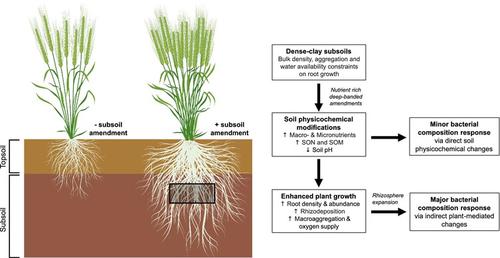当前位置:
X-MOL 学术
›
Environ. Microbiol.
›
论文详情
Our official English website, www.x-mol.net, welcomes your feedback! (Note: you will need to create a separate account there.)
Bacterial community shifts occur primarily through rhizosphere expansion in response to subsoil amendments
Environmental Microbiology ( IF 5.1 ) Pub Date : 2024-03-08 , DOI: 10.1111/1462-2920.16587 Joshua J. Vido 1 , Xiaojuan Wang 2, 3 , Peter W. G. Sale 2 , Corinne Celestina 2, 3 , Anya E. Shindler 1 , Helen L. Hayden 3, 4 , Caixian Tang 2 , Jennifer L. Wood 1, 5 , Ashley E. Franks 1, 5
Environmental Microbiology ( IF 5.1 ) Pub Date : 2024-03-08 , DOI: 10.1111/1462-2920.16587 Joshua J. Vido 1 , Xiaojuan Wang 2, 3 , Peter W. G. Sale 2 , Corinne Celestina 2, 3 , Anya E. Shindler 1 , Helen L. Hayden 3, 4 , Caixian Tang 2 , Jennifer L. Wood 1, 5 , Ashley E. Franks 1, 5
Affiliation

|
To comprehensively evaluate the impact of agricultural management practices on soil productivity, it is imperative to conduct a thorough analysis of soil bacterial ecology. Deep‐banding nutrient‐rich amendments is a soil management practice that aims to improve plant growth and soil structure by addressing the plant‐growth constraints posed by dense‐clay subsoils. However, the response of bacterial communities to deep‐banded amendments has not been thoroughly studied. To address this knowledge gap, we conducted a controlled‐environment column experiment to examine the effects of different types of soil amendments (poultry litter, wheat straw + chemical fertiliser and chemical fertiliser alone) on bacterial taxonomic composition in simulated dense‐clay subsoils. We evaluated the bacterial taxonomic and ecological group composition in soils beside and below the amendment using 16S rRNA amplicon sequencing and robust statistical methods. Our results indicate that deep‐banded amendments alter bacterial communities through direct and indirect mechanisms. All amendments directly facilitated a shift in bacterial communities in the absence of growing wheat. However, a combination of amendments with growing wheat led to a more pronounced bacterial community shift which was distinct from and eclipsed the direct impact of the amendments and plants alone. This indirect mechanism was evidenced to be mediated primarily by plant growth and hypothesised to result from an enhancement in wheat root distribution, density and rhizodeposition changes. Therefore, we propose that subsoil amendments regardless of type facilitated an expansion in the rhizosphere which engineered a substantial plant‐mediated bacterial community response within the simulated dense‐clay subsoils. Overall, our findings highlight the importance of considering the complex and synergistic interactions between soil physicochemical properties, plant growth and bacterial communities when assessing agricultural management strategies for improving soil and plant productivity.
中文翻译:

细菌群落的变化主要是通过根际扩张来响应底土修正而发生的
为了全面评估农业管理措施对土壤生产力的影响,必须对土壤细菌生态进行彻底分析。深层营养丰富的改良剂是一种土壤管理实践,旨在通过解决致密粘土底土对植物生长的限制来改善植物生长和土壤结构。然而,细菌群落对深带修正的反应尚未得到彻底研究。为了解决这一知识差距,我们进行了受控环境柱实验,以研究不同类型的土壤改良剂(家禽凋落物、麦秆+化肥和单独化肥)对模拟致密粘土底土中细菌分类组成的影响。我们使用 16S rRNA 扩增子测序和稳健的统计方法评估了修正前后土壤中的细菌分类和生态群组成。我们的结果表明,深带状修正通过直接和间接机制改变细菌群落。在没有种植小麦的情况下,所有修正案都直接促进了细菌群落的转变。然而,修正与种植小麦的结合导致了更明显的细菌群落变化,这与单独修正和植物的直接影响不同,并且使之黯然失色。事实证明,这种间接机制主要由植物生长介导,并推测是由于小麦根系分布、密度和根际沉积变化的增强所致。因此,我们建议,无论类型如何,底土改良都会促进根际的扩张,从而在模拟的致密粘土底土中产生大量植物介导的细菌群落反应。总体而言,我们的研究结果强调了在评估提高土壤和植物生产力的农业管理策略时考虑土壤理化性质、植物生长和细菌群落之间复杂且协同的相互作用的重要性。
更新日期:2024-03-08
中文翻译:

细菌群落的变化主要是通过根际扩张来响应底土修正而发生的
为了全面评估农业管理措施对土壤生产力的影响,必须对土壤细菌生态进行彻底分析。深层营养丰富的改良剂是一种土壤管理实践,旨在通过解决致密粘土底土对植物生长的限制来改善植物生长和土壤结构。然而,细菌群落对深带修正的反应尚未得到彻底研究。为了解决这一知识差距,我们进行了受控环境柱实验,以研究不同类型的土壤改良剂(家禽凋落物、麦秆+化肥和单独化肥)对模拟致密粘土底土中细菌分类组成的影响。我们使用 16S rRNA 扩增子测序和稳健的统计方法评估了修正前后土壤中的细菌分类和生态群组成。我们的结果表明,深带状修正通过直接和间接机制改变细菌群落。在没有种植小麦的情况下,所有修正案都直接促进了细菌群落的转变。然而,修正与种植小麦的结合导致了更明显的细菌群落变化,这与单独修正和植物的直接影响不同,并且使之黯然失色。事实证明,这种间接机制主要由植物生长介导,并推测是由于小麦根系分布、密度和根际沉积变化的增强所致。因此,我们建议,无论类型如何,底土改良都会促进根际的扩张,从而在模拟的致密粘土底土中产生大量植物介导的细菌群落反应。总体而言,我们的研究结果强调了在评估提高土壤和植物生产力的农业管理策略时考虑土壤理化性质、植物生长和细菌群落之间复杂且协同的相互作用的重要性。



























 京公网安备 11010802027423号
京公网安备 11010802027423号